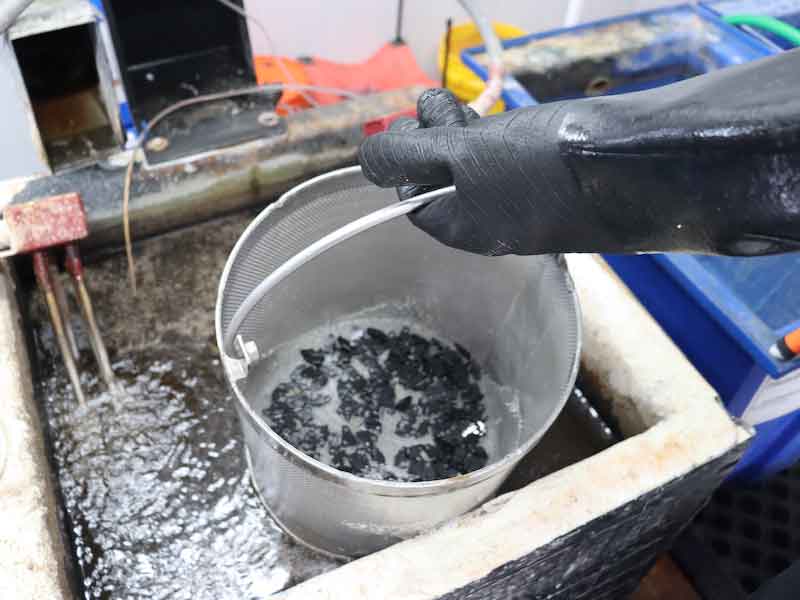Any process only provides optimum performance if the contributing parts are satisfactorily functioning.
 Stephen F. Rudy CEFA common phrase linked to computers highlights the importance of programming or entering data. If quality is entered, a quality outcome can be expected. Likewise, if poor information or “garbage” is entered, the same can be the expected outcome. Metal finishing processes exemplify this because each step or treatment is critical to achieving the preferred end result. In this respect, I have always acknowledged the importance of surface preparation, especially cleaning, to be the first big critical step in any finishing cycle.
Stephen F. Rudy CEFA common phrase linked to computers highlights the importance of programming or entering data. If quality is entered, a quality outcome can be expected. Likewise, if poor information or “garbage” is entered, the same can be the expected outcome. Metal finishing processes exemplify this because each step or treatment is critical to achieving the preferred end result. In this respect, I have always acknowledged the importance of surface preparation, especially cleaning, to be the first big critical step in any finishing cycle.
At least three-quarters of process rejects can be traced to failures in surface preparation. In this regard, the first step is the most important step.
Poor cleaning manifests itself in the form of common rejects such as adhesion and blisters — plating, paint, chromate, phosphate, etc. — deposit hazes, clouds, and pitting. In addition, dragging oily soils down a process line contaminants rinses and process tanks. Any of these conditions reduce quality, result in costly rejects and affect desired production schedules.
By focusing on cleaning, let’s review some pertinent information that can keep this first step a successful one.
Identifying the Best Soak Cleaner
There is always some degree of evaluation associated with identifying the best soak cleaner to use in a specific application, operating within certain parameters. Suppliers provide liquid and powder cleaners that have been developed to remove a wide range of oils, grease, and shop dirt. A new cleaning application may require help to identify or confirm the types of oils that must be removed. This also applies to situations where something has changed, thus inhibiting the usual reliability of the cleaner. Manufacturers submitting parts to the finisher can provide samples of the oils or technical data information. This helps when selecting a cleaner or related modification.
Suppliers have a very good background in what types of their cleaner formulations work best to remove specific soils or groups thereof. Even the types of parts for processing can be helpful in selecting candidate cleaners. Examples would be extruded parts that may contain molybdenum disulfide additives or steel stampings filmed with chlorinated paraffin. Suppliers or local labs equipped with appropriate instrumentation may be able to identify unknown oils. Simple, quick, qualitative analysis can also be very helpful. The following lab testing, using proper care, safety, and protection, can also be considered. Results may not be conclusive but can give a direction in the cleaner selection and evaluation.
- Add equal volumes of the oil and water to a test tube. Shake well. If there is a separation, either the oil or water is the surface layer. If the oil is the bottom layer (denser), it could be a chlorinated or mineral type.
- The previous oil and water, on mixing, becomes cloudy or tan/white opaque. This would indicate a water-soluble or emulsifiable oil.
- Pour some oil into a test tube. Add a few drops of dilute hydrochloric acid and gently heat. An odor of sulfur (rotten eggs type) indicates a sulfurized oil.
- Pour an equal volume of the oil and water into a test tube. Mix well. There is a distinct separation of the layers. Add a few drops of liquid caustic. Mix again. The oil has now become soluble or emulsified in the water layer. The result indicates a fatty acid in the initial oil sample.
- Pour some oil into a test tube. Add a few drops of liquid caustic and mix well. If the solution thickens, gels, or congeals, this would indicate the presence of chlorinated oil.
Conduct Appropriate Cleaning Tests
Once candidate cleaners have been selected, appropriate cleaning tests are conducted. This can be accomplished in the lab, a pilot plant, or in on-site trials. Once the formulations that provide satisfactory cleaning have been identified, the optimum cleaning operating parameters can be determined (time, temperature, and concentration). Once these have been established, the selected cleaner bath can be aged through repeated cleaning. Or, if in the lab-scale evaluation, the working candidate cleaner can be artificially aged by adding a set volume of the oily soil or a mixture of the various oils, the cleaner will be expected to remove off the parts. Maintenance additions made to restore desired cleaning effect can be confirmed. This evaluation also confirms how much contaminant soil the cleaner can accept and the anticipated economy of cleaner bath service life between dumps. A rule of thumb is the ability to add at least twice the maintenance amount of cleaner compared to the initial makeup.
Once the actual cleaner bath service life has been established, measure the specific gravity of the solution before dumping it (product concentration should be equivalent to the initial makeup.). The specific gravity will indicate how much-dissolved soils, emulsified oils, and suspended materials are in solution. Repeat this measurement for the newly prepared cleaner. As the cleaner bath is analyzed (most likely a titration procedure), also measure the specific gravity. This may serve as a useful precaution for tracking the effective service life of the bath, especially where conventional analysis may not be a sufficient predictor of service life. In this way, cleaning rejects may be more readily avoided, and scheduled downtime can be planned to avoid unwanted line shutdown.
Another method to test the efficiency of the working cleaner is to conduct a process test using known clean panels.
- Immerse the panel (ex. steel hull cell type) in the working cleaner for 1-2 minutes with gentle agitation.
- Remove the panel and rinse in clean, cold running water for 30 seconds.
If on inspection there are water breaks, add 10%-20% initial concentrated soak cleaner to the sample of working cleaner. Then repeat steps 1 and 2.
- If water breaks have not been eliminated, consider replacing the aged soak cleaner with fresh makeup.
- If after step 2 there are no water breaks, dip the water break free panel in a 5% solution of hydrochloric or sulfuric acid.
- Remove the panel and rinse in clean, cold running water for 30 seconds.
If the panel is water break free, the soak cleaner condition is sufficient to clean parts in the production line. If after step 5 there are water breaks, this may indicate residual oily film on the panel that is only evident upon rinsing after the acid dip. This type of water break would also indicate it is appropriate to replace the soak cleaner with fresh makeup.
Selecting the right cleaner and properly maintaining it with respect to operating parameters will go a long way to ensure that the first big step is successful.
Acid Pickling Tips
Hydrochloric acid is excellent for removing weld scale from parts. It is also an excellent selection for treating high carbon, hot rolled steel. Typical operating parameters are 15% to 50% vol, 80°F to 120°F (27°C to 49°C)
Sulfuric acid is preferred for low-carbon, cold-rolled steel. Typical operating parameters are 5% to 15% vol, 75°F to 100°F (27°C to 38°C).
Plating rejects may also often occur by using the wrong acid or applying it incorrectly. An example is over pickling, which results in etching, hazing, speckling, and pitting.
Stephen F. Rudy, CEF, is president of Chem Analytic and has written extensively about the finishing industry. Visit www.chemanalytic.com or call him at 917-604-5001.



































